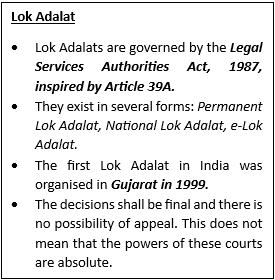SYLLABUS
GS-2: Structure, organization and functioning of the Executive and the Judiciary.
Context: The Minister of Law and Justice emphasised the need for global cooperation to strengthen Alternative Dispute Resolution (ADR) mechanisms.
About the Alternative Dispute Resolution (ADR)
• ADR refers to mechanisms that settle disputes outside traditional courts.
• It involves neutral facilitation or direct dialogue to reach mutual agreements efficiently and confidentially.
• Mechanisms of ADR:
- Mediation: A neutral mediator helps the disputing parties discuss the issues and reach a voluntary agreement, but the mediator does not make a binding decision.
- Arbitration: Parties present their case to an arbitrator, who then makes a decision that is generally binding and enforceable.
- Negotiation: Parties engage in direct discussion to resolve their differences without the involvement of a neutral third party.
- Conciliation: An informal, voluntary dispute resolution where a neutral conciliator helps parties communicate and may suggest non-binding solutions.
- Neutral Evaluation: A neutral third party provides an opinion on the likely outcome of the case if it were to go to court.
- Judicial Settlement/ Lok Adalat: A mechanism in India for amicable settlement of disputes outside the formal court system.

Constitutional and Legal basis of ADR
• Constitutional Basis:
- Article 14 and Article 21: ADR is rooted in Article 14 (equality before law) and Article 21 (right to life and personal liberty), ensuring fair and timely justice for all individuals.
- Article 39A: It directs the state to promote equal justice and free legal aid, enabling ADR as a means to guarantee justice for weaker section.
• Legal Basis:
- The Arbitration and Conciliation Act, 1996: primary statute regulating arbitration and conciliation, covering both domestic and international disputes.
- Civil Procedure Code, 1908: Section 89 empowers courts to refer cases for ADR, including arbitration, mediation, conciliation, or Lok Adalat.
- Legal Services Authorities Act, 1987: Establishes the framework for Lok Adalats and legal aid, including ADR mechanisms.
- Mediation Act, 2023: Provides a formal statutory framework for institutional mediation, detailing appointment, conduct, and enforceability of mediated settlements.
Significance of the ADR
• Addressing System Inefficiencies:
- Pendency of cases: According to the National Judicial Data Grid (NJDG), the total number of pending cases in India is 4,57,96,239; in the Supreme Court, 81,768, and in the High Courts, approximately 62.9 lakh.
- High Vacany Rate: The India Justice Report highlights that High Courts and district courts are facing vacancy rates of 33% and 21%, respectively.
- Judicial Workload: Judges in Uttar Pradesh, Himachal Pradesh and Kerala have workloads exceeding 4,000 cases.
• Social and Procedural Advantages:
- Social Change Catalyst: Former Chief Justice of India, Justice D.Y. Chandrachud, describes mediation as a tool for social change, aligning social norms with constitutional values through dialogue and information exchange.
- Flexibility and Party Control: Parties have greater autonomy in ADR, including selecting decision-makers, choosing applicable laws, and controlling the process rules and procedures.
- Amicable and Creative Solutions: ADR allow for creative and satisfactory outcomes tailored to the parties’ specific needs, leading to more sustainable resolutions.

